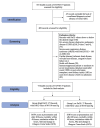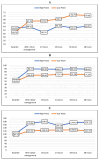The Comparative Impact of Liberal Versus Conservative Oxygenation in Critically Ill COVID-19 Patients: A Retrospective Study
- PMID: 39323662
- PMCID: PMC11423557
- DOI: 10.7759/cureus.67809
The Comparative Impact of Liberal Versus Conservative Oxygenation in Critically Ill COVID-19 Patients: A Retrospective Study
Abstract
Objectives Whether a higher or lower partial pressure of oxygen (PaO2) could impact outcomes in patients with coronavirus disease 2019 (COVID-19) remains a matter of debate. So, we planned this retrospective analysis to determine if a higher or lower partial pressure of oxygen in blood had any effect on outcomes in COVID-19 patients. Material and method The records of COVID-19 patients from the beginning of 2020 to the end of 2022 were scanned. Patients were sub-grouped into two groups based on the partial pressure of oxygen (PaO2) values on arterial blood gas (ABG), i.e., high PaO2 group, PaO2 value of 80-100 mm Hg, and low PaO2 group, PaO2 value of 60-80 mm Hg for the first 48 hours after the initiation of oxygenation and/or mechanical ventilation. The two groups were compared in terms of partial pressure of oxygen in arterial blood to the fraction of inspiratory oxygen (FiO2) concentration (P/F ratio), Sequential Organ Failure Assessment (SOFA) score at presentation and after 48 hours, and clinical outcomes, including mortality, time of mortality, extubation, acute kidney injury (AKI), and change in Glasgow Coma Scale (GCS). Results SOFA score was significantly higher in the low PaO2 group as compared to the high PaO2 group both at baseline (4.59 {1.79} versus 5.51 {1.15}; p-value: 0.005) and at 48 hours (3.06 {1.39} versus 5.11 {2.13}; p-value: 0.007). However, the change in SOFA score over 48 hours did not achieve statistical significance (-1.000 {0.97} versus 0.53 {2.34}; p-value: 0.257). Out of a total of 37 patients, 21 patients died in the high PaO2 group, while 18 patients died in the low PaO2 group. Conclusion Our study highlights that targeting either low or high arterial oxygen content while considering oxygen therapy for COVID-19 patients did not significantly alter the outcomes.
Keywords: acute kidney injury; covid-19; glasgow coma scale; lactates; oxygen inhalation therapy; sequential organ failure assessment score.
Copyright © 2024, Singla et al.
Conflict of interest statement
Human subjects: Consent was obtained or waived by all participants in this study. The Institutional Ethics Committee of the All India Institute of Medical Sciences, Rishikesh, issued approval AIIMS/IEC/24/297. Animal subjects: All authors have confirmed that this study did not involve animal subjects or tissue. Conflicts of interest: In compliance with the ICMJE uniform disclosure form, all authors declare the following: Payment/services info: All authors have declared that no financial support was received from any organization for the submitted work. Financial relationships: All authors have declared that they have no financial relationships at present or within the previous three years with any organizations that might have an interest in the submitted work. Other relationships: All authors have declared that there are no other relationships or activities that could appear to have influenced the submitted work.
Figures



Similar articles
-
[Risk factors analysis of acute respiratory distress syndrome in intensive care unit traumatic patients].Zhonghua Wei Zhong Bing Ji Jiu Yi Xue. 2018 Oct;30(10):978-982. doi: 10.3760/cma.j.issn.2095-4352.2018.010.015. Zhonghua Wei Zhong Bing Ji Jiu Yi Xue. 2018. PMID: 30439321 Chinese.
-
[Predictive value of four different scoring systems for septic patient's outcome: a retrospective analysis with 311 patients].Zhonghua Wei Zhong Bing Ji Jiu Yi Xue. 2017 Feb;29(2):133-138. doi: 10.3760/cma.j.issn.2095-4352.2017.02.008. Zhonghua Wei Zhong Bing Ji Jiu Yi Xue. 2017. PMID: 28625260 Chinese.
-
Effect of Low-Normal vs High-Normal Oxygenation Targets on Organ Dysfunction in Critically Ill Patients: A Randomized Clinical Trial.JAMA. 2021 Sep 14;326(10):940-948. doi: 10.1001/jama.2021.13011. JAMA. 2021. PMID: 34463696 Free PMC article. Clinical Trial.
-
Comparison of High-Flow Nasal Cannula Versus Conventional Oxygen Therapy After Extubation in Children Undergoing Cardiac Surgery: A Meta-analysis.Cureus. 2023 Mar 30;15(3):e36922. doi: 10.7759/cureus.36922. eCollection 2023 Mar. Cureus. 2023. PMID: 37128521 Free PMC article. Review.
-
Higher versus lower fractions of inspired oxygen or targets of arterial oxygenation for adults admitted to the intensive care unit.Cochrane Database Syst Rev. 2023 Sep 13;9(9):CD012631. doi: 10.1002/14651858.CD012631.pub3. Cochrane Database Syst Rev. 2023. PMID: 37700687 Free PMC article. Review.
References
-
- Effect of high perioperative oxygen fraction on surgical site infection and pulmonary complications after abdominal surgery: the PROXI randomized clinical trial. Meyhoff CS, Wetterslev J, Jorgensen LN, et al. JAMA. 2009;302:1543–1550. - PubMed
-
- Effect of conservative vs conventional oxygen therapy on mortality among patients in an intensive care unit: the oxygen-ICU randomized clinical trial. Girardis M, Busani S, Damiani E, et al. JAMA. 2016;316:1583–1589. - PubMed
LinkOut - more resources
Full Text Sources
